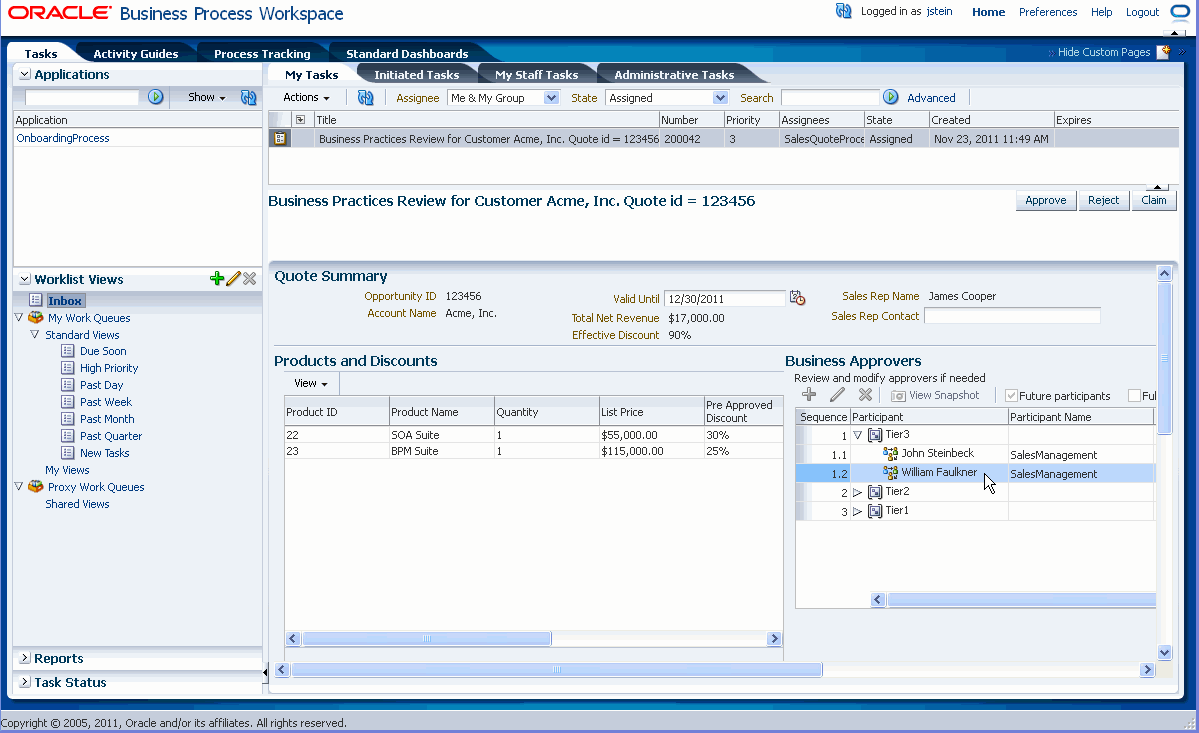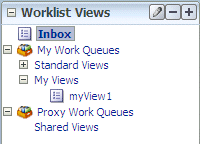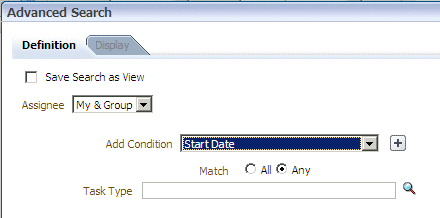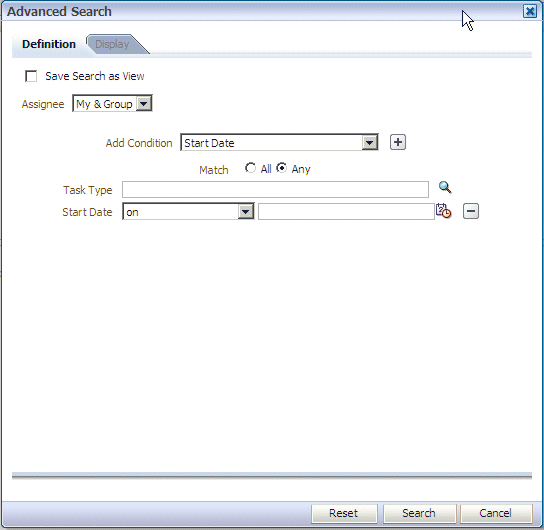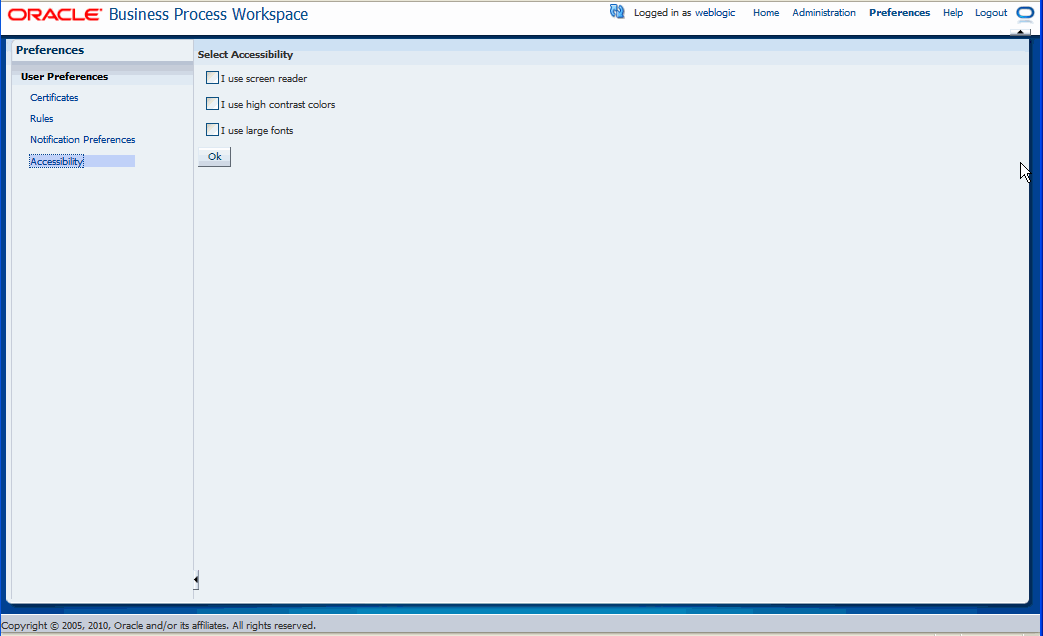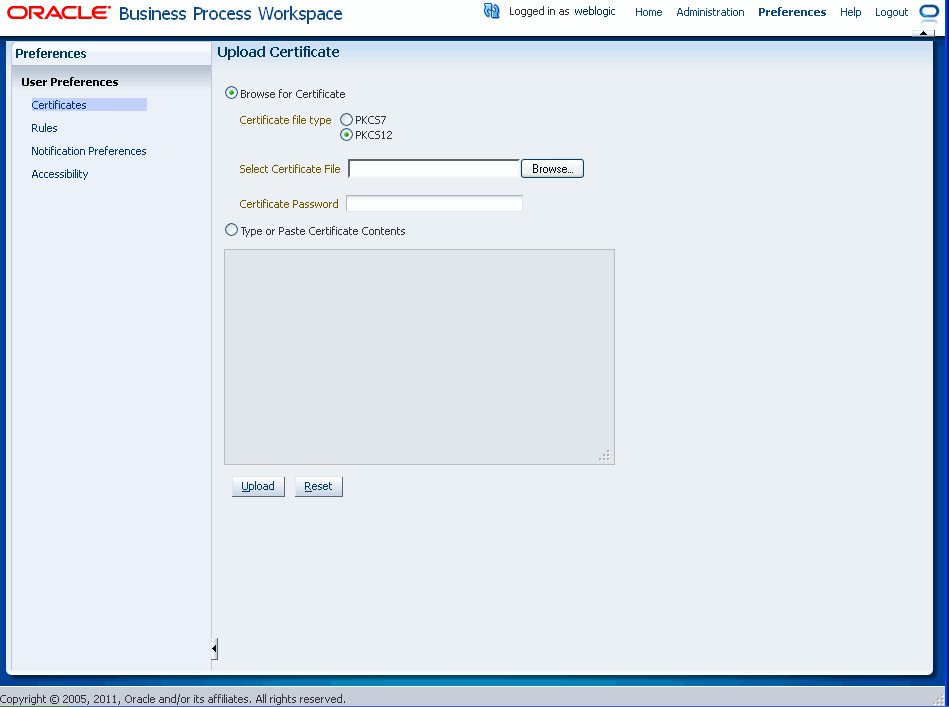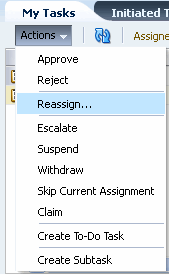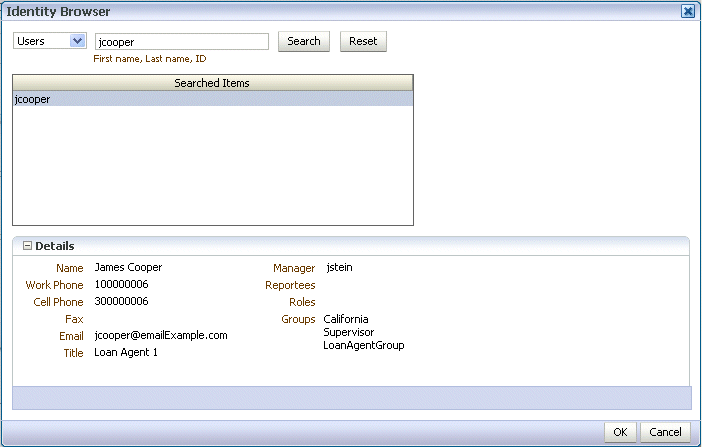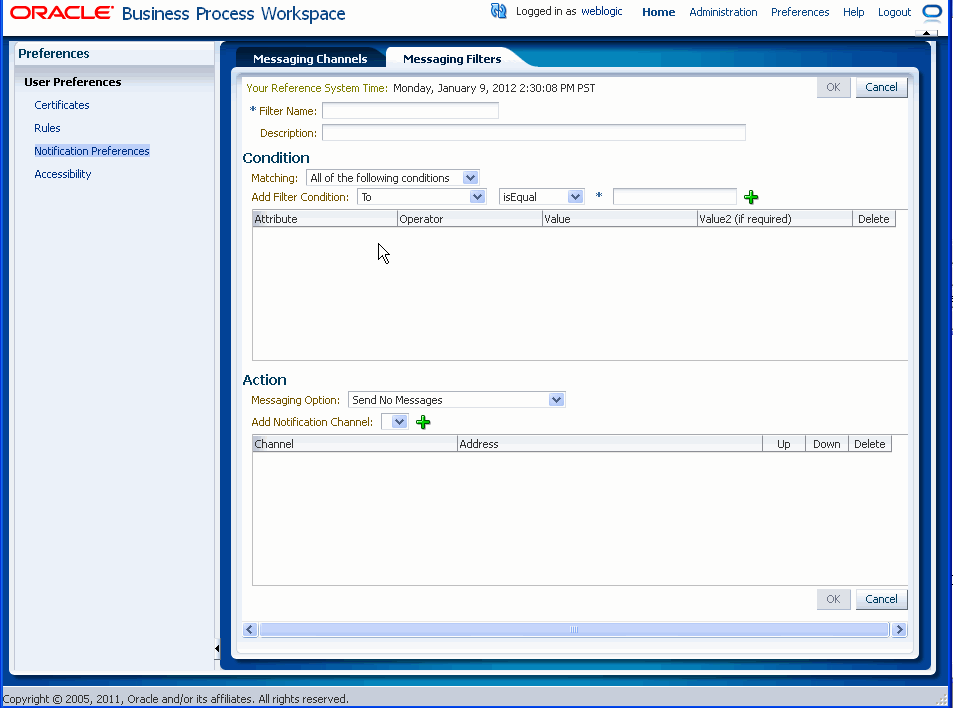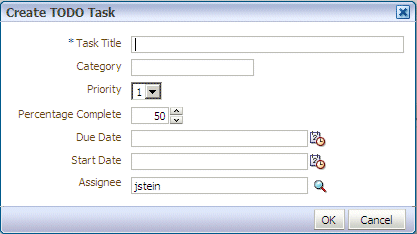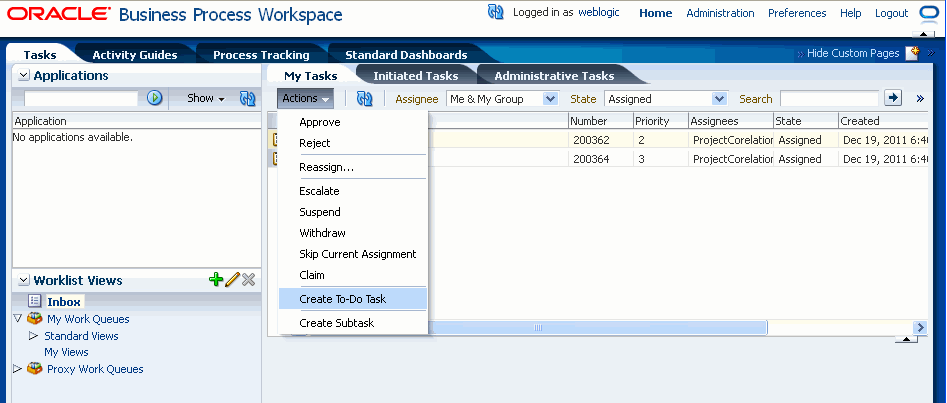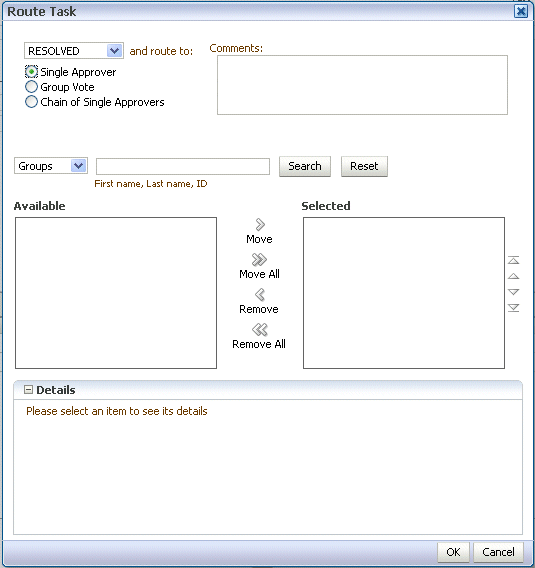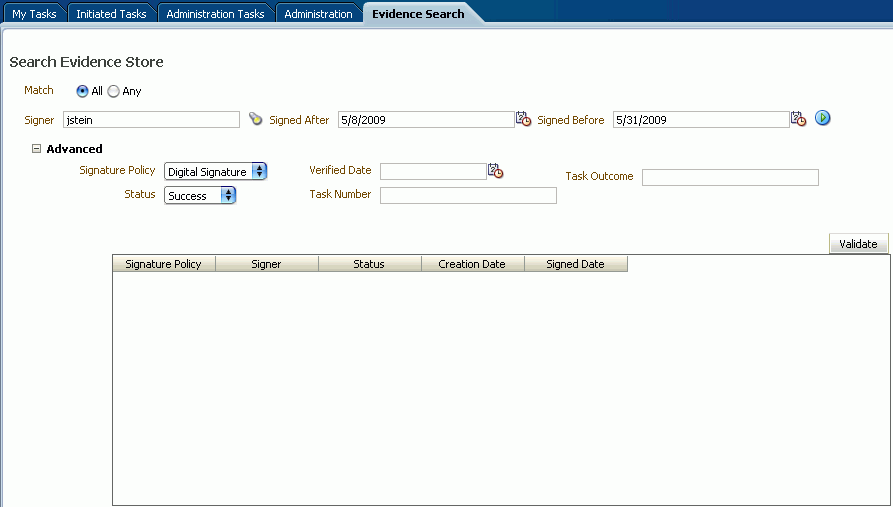3 Working on Tasks in Process Workspace
This chapter describes how to set user preferences and act on tasks with Oracle Business Process Management Workspace, including claiming and releasing tasks; reassigning, delegating, and routing tasks; associating comments and attachments to tasks; and setting rules and vacation periods
This chapter contains these topics:
-
Section 3.1, "What You Need to Know When Acting on Tasks in Process Workspace"
-
Section 3.2, "Working with the Process Workspace Tasks Page"
-
Section 3.3, "Claiming and Releasing Tasks in Process Workspace"
-
Section 3.4, "Setting Accessibility Preferences in Process Workspace"
-
Section 3.5, "Providing a Digital Certificate in Process Workspace"
-
Section 3.6, "Reassigning and Delegating Tasks in Process Workspace"
-
Section 3.7, "Adding Comments and Attachments to Tasks in Process Workspace"
-
Section 3.9, "Setting Rules, Vacation Periods, and Notification Preferences in Process Workspace"
-
Section 3.10, "Creating ToDo Tasks and Subtasks in Process Workspace"
-
Section 3.11, "Acting on Tasks that Require Passwords in Process Workspace"
-
Section 3.12, "Acting on a Task that Requires a Digital Signature in Process Workspace"
-
Section 3.14, "Evidence Store Service and Digital Signatures"
For information about troubleshooting human workflow issues, see section "Human Workflow Troubleshooting" of Oracle Fusion Middleware Administrator's Guide for Oracle SOA Suite and Oracle Business Process Management Suite.
3.1 What You Need to Know When Acting on Tasks in Process Workspace
Here are a few things to keep in mind when acting on tasks:
-
If the human task was designed to permit ad hoc routing, or if no predetermined sequence of approvers was defined, then the task can be routed in an ad hoc fashion in the worklist. For such tasks, a Route button appears on the task details page. From the Route page, you can look up one or more users for routing. When you specify multiple assignees, you can select whether the list of assignees is for simple (group assignment to all users), sequential, or parallel assignment.
If you are a developer and want more information about designing tasks to permit ad hoc routing, see Oracle Fusion Middleware Developer's Guide for Oracle SOA Suite.
-
Parallel tasks are created when a parallel flow pattern is specified for scenarios such as voting. In this pattern, the parallel tasks have a common parent. The parent task is visible to a user only if the user is an assignee or either an owner or a creator of the task.
The parallel tasks themselves (referred to as subtasks) are visible to whomever the task is assigned, just like any other task.
You can view the subtasks from a parent task. In such a scenario, the task details page of the parent task contains a View SubTasks button. The SubTasks page lists the corresponding parallel tasks.
In a voting scenario, if any of the assignees updates the payload, the comments, or the attachments, then the changes are visible only to the assignee of that task. A user who can view the parent task (such as the final reviewer of a parallel flow pattern), can drill down to the subtasks and view the updates to the subtasks made by the participants in the parallel flow.
In the worklist, you provide the percentage of votes required for approval.
-
If a human task was set up to require a password, then when you act on it, you must provide the password.
Note:
Any kind of change to the task details page, such as changing a priority or adding either a comment or an attachment, requires you to save the change.
3.2 Working with the Process Workspace Tasks Page
This section contains these topics:
3.2.1 Viewing Task Details in Process Workspace
You perform most tasks in Process Workspace by using the Task Details page.
To display the Task Details page:
-
In the Home page, select the Tasks page, expand the Worklist Views section, and select Inbox. The right pane displays the My Tasks page as shown in the example in Figure 3-1. This page lists all the tasks and work items assigned to you, depending on your role. For example, all users can see the My Tasks, Initiated Tasks and Administrative Tasks pages. Only supervisors can see the My Staff page and only process owners can see the Owner Tasks page.
-
To display the details of a task inline, select the task in the right pane. The details are displayed in the lower right pane. To display the task details in a pop-up window, double-click the task. Figure 3-2 shows an example of a Task Details page.
Figure 3-2 Example of a Task Details Page
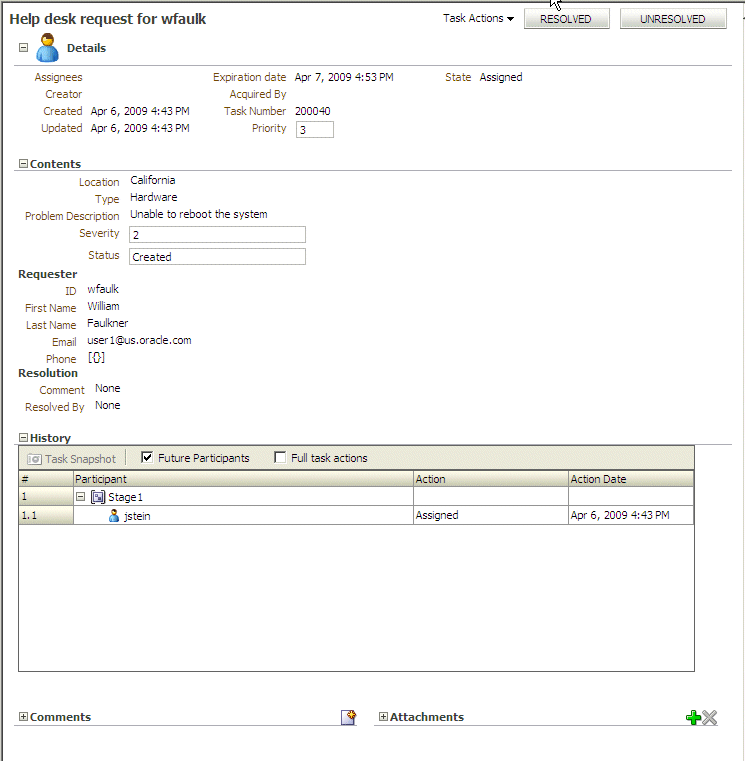
Description of "Figure 3-2 Example of a Task Details Page"
For more information about the Task Details page, see Section 2.3.1.2, "The Process Workspace Task Details Page"
3.2.1.1 Performing System Actions in Process Workspace
The action bar of the Task Details page displays system actions, which are available on all tasks based on the user's privileges. Table 3-1 lists system actions.
| Action | Description |
|---|---|
|
Claim |
Use this action to claim a task that is assigned to a group or multiple users. Claim is the only action available in the Task Action list for group or multiuser assignments. After a task is claimed, all applicable actions are listed. |
|
Escalate |
Use this action to escalate a task that is assigned to a group or multiple users. You can add an optional comment in the Comments area. The task is reassigned to whomever is specified by the administrator. If no escalation path is specified, then the task is escalated to your manager (up one level in a hierarchy). |
|
Pushback |
Use this action to send a task down one level in the workflow to the previous assignee. |
|
Reassign |
Use this action to assign a task to someone else. If you are a manager, you can delegate a task to reportees. A user with BPMWorkflowReassign privileges can delegate a task to anyone. |
|
Release |
Use this action to release a claimed task. If a task is assigned to a group or multiple users, it can be released if the user who claimed the task cannot complete the task. Any of the other assignees can claim and complete the task. |
|
Renew |
Use this task to extend a task's expiration date. You can add an optional comment in the Comments area. The task expiration date is extended 1 week. A renewal appears in the task history. The renewal duration for a task can be controlled by an optional parameter. The default value is |
|
Submit Information and Request Information |
Use these actions if another user requests that you supply more information or to request more information from the task creator or any of the previous assignees. If reapproval is not required, then the task is assigned to the next approver or the next step in the business process. |
|
Suspend and Resume |
Use these actions to suspend or restart a task. These options are available only to users who have been granted the BPMWorkflowSuspend role. Other users can access the task by selecting Previous in the task filter or by looking up tasks in the Suspended status. A suspension is indefinite. It does not expire until Resume is used to resume working on the task. |
|
Withdraw |
Use this action to cancel a task. If you are the creator of a task and do not want to continue with it, for example, you want to cancel a vacation request, you can withdraw it and add an optional comment in the Comments area. The business process determines what happens next. You can use the Withdraw action on the home page by using the Creator task filter. |
For more information about the Task Details page, see Section 2.3.1.2, "The Process Workspace Task Details Page"
3.2.2 Customizing the Task List in Process Workspace
You can customize your task list in several ways, including adding worklist views, selecting which columns to display, and displaying a subset of the tasks based on filter criteria.
To increase the number of tasks retrieved, resize the task list display area.
This section contain these topics:
3.2.2.1 How to Filter Tasks
Figure 3-3 shows the filter fields.
Figure 3-3 Filters: Assignee, Status, Search, and Advanced Search

Description of "Figure 3-3 Filters: Assignee, Status, Search, and Advanced Search "
Filters are used to display a subset of tasks, based on the following filter criteria:
-
Assignee
From the My Tasks page, select from the following:
-
My: Retrieves tasks directly assigned to the logged-in user
-
Group: Retrieves the following:
-
Tasks that are assigned to groups to which the logged-in user belongs
-
Tasks that are assigned to an application role that the logged-in user is assigned
-
Tasks that are assigned to multiple users, one of which is the logged-in user
-
-
My & Group: Retrieves all tasks assigned to the user, whether through direct assignment, or by way of a group, application role, or list of users
-
Previous: Retrieves tasks that the logged-in user has updated
-
Reviewer: Retrieves task for which the logged-in user is a reviewer
From the Initiated Tasks page, select Creator.
From the My Staff Tasks page, select Reportees.
From the Administrative Tasks page, select Admin.
-
-
Status: Select from the following: Any, Assigned, Completed, Suspended (can be resumed later), Withdrawn, Expired, Errored (while processing), Alerted, or Information Requested.
-
Search: Enter a keyword to search task titles, comments, identification keys, and the flex string fields of tasks that qualify for the specified filter criterion.
-
Advanced: Provides additional search filters.
Note:
If a task is assigned separately to multiple reportees, when a manager looks at the My Staff Tasks list, the manager sees as many copies of that task as the number of reportees to whom that task is assigned.
To filter tasks based on assignee or status:
Select options from the Assignee and Status lists. The task list is automatically updated based on the filter selections.
To filter tasks based on keyword search:
-
Enter a keyword to search task titles, comments, identification keys, and the flex string fields of tasks that qualify for the specified filter criterion.
-
Press Enter or click Refresh.
To filter tasks based on an advanced search:
Mapped attribute labels can be used in an advanced search if you select task types for which mapped attribute have been defined.
See Section 9.2.1.1, "How to Specify Mapped Attributes" for more information.
-
Click Advanced.
-
(Optional) Select Save As View, provide a view name, and use the Display page to provide other information, as shown in Figure 3-4 and Figure 3-5.
Figure 3-4 Worklist Advanced Search: Definition Page

Description of "Figure 3-4 Worklist Advanced Search: Definition Page"
Figure 3-5 Worklist Advanced Search: Display Page

Description of "Figure 3-5 Worklist Advanced Search: Display Page"
Table 3-2 describes the advanced search view columns available in the Display page.
Table 3-2 Advanced Search—View Columns
Column Description Start Date
The start date of the task (used with ToDo tasks).
Task Definition Name
The name of the task component that defines the task instance.
Owner Role
The application role (if any) that owns the task instance. Task owners can be application roles, users, or groups. If the owner of the task is an application role, this field is set.
Updated Date
The date the task instance was last updated.
Composite Version
The version of the composite that contains the task component that defines the task instance.
Creator
The name of the creator of the task.
From User
The from user for the task.
Percentage Complete
The percentage of the task completed (used with ToDo tasks).
Owner Group
The group (if any) that owns the task instance. Task owners can be application roles, users, or groups. If the owner of the task is a group, this field is set.
End Date
The end date of the task (used with ToDo tasks).
Composite
The name of the composite that contains the task component that defines the task instance.
Due Date
The due date of the task (used with ToDo tasks).
Composite Distinguished Name
The unique name for the particular deployment of the composite that contains the task component that defines the task instance.
Task Display URL
The URL to display the details for the task.
Updated By
The user who last updated the task.
Outcome
The outcome of the task, for example Approved or Rejected. This is only set on completed task instances.
Task Namespace
A namespace that uniquely defines all versions of the task component that defines this task instance. Different versions of the same task component can have the same namespace, but no two task components can have the same namespace.
Approvers
The approvers of the task.
Application Context
The application to which any application roles associated with the tasks (such as assignees, owners, and so on) belong.
Owner User
The user (if any) that owns the task instance. Task owners can be application roles, users, or groups. If the owner of the task is a user, this field is set.
Identifier
The (optional) custom unique identifier for the task. This is an additional unique identifier to the standard task number.
Category
The category of the task.
Acquired By
The name of the user who claimed the task in the case when the task is assigned to a group, application role, or to multiple users, and then claimed by the user.
Component
The name of the task component that defines the task instance.
Original Assignee User
The name of the user who delegated the task in the case when the user delegates a task to another user.
Assigned
The date that this task was assigned.
Partition
The domain to which the composite that contains the task component that defines the task instance belongs.
Title
The title of the task.
Number
An integer that uniquely identifies the task instance.
Priority
An integer that defines the priority of the task. A lower number indicates a higher priority—typically numbers 1 to 5 are used.
Assignees
The current task assignees (users, groups or application roles).
State
The state of the task instance.
Created
The date that the task instance was created.
Expires
The date on which the task instance expires.
Custom Date 1
Custom flex field 1 with Date datatype
Custom Date 2
Custom flex field 2 with Date datatype
Custom String 1
Custom flex field 1 with String datatype
Custom String 2
Custom flex field 2 with String datatype
Custom Number 1
Custom flex field 1 with Number datatype
Custom Number 2
Custom flex field 2 with Number datatype
The saved view appears in the Inbox under My Views, as shown in Figure 3-6.
-
Select an assignee, as shown in Figure 3-7.
-
Add conditions (filters), as shown in Figure 3-8.
Figure 3-8 Adding Filters for an Advanced Search on Tasks

Description of "Figure 3-8 Adding Filters for an Advanced Search on Tasks"
Table 3-3 describes the available conditions.
Table 3-3 Advanced Search: Conditions
Condition Description Start Date
The start date of the task (used with ToDo tasks).
Assignees
The current task assignees (users, groups or application roles).
Task Definition Name
The name of the task component that defines the task instance.
Owner Role
The application role (if any) that owns the task instance. Task owners can be application roles, users, or groups. If the owner of the task is an application role, this field is set.
Updated Date
The date that the task instance was last updated.
Created
The date that the task instance was created.
Composite Version
The version of the composite that contains the task component that defines the task instance.
Creator
The name of the creator of the task.
From User
The from user for the task.
Percentage Complete
The percentage of the task completed (used with ToDo tasks).
Title
The title of the task.
Owner Group
The group (if any) that owns the task instance. Task owners can be application roles, users, or groups. If the owner of the task is a group, this field is set.
End Date
The end date of the task (used with ToDo tasks).
Priority
An integer that defines the priority of the task. A lower number indicates a higher priority; typically numbers 1 to 5 are used.
Number
An integer that uniquely identifies the task instance.
Composite
The name of the composite that contains the task component that defines the task instance.
Due Date
The due date of the task (used with ToDo tasks).
State
The state of the task instance.
Composite Distinguished Name
The unique name for the particular deployment of the composite that contains the task component that defines the task instance.
Task Display URL
The URL to display the details for the task.
Updated By
The user who last updated the task.
Outcome
The outcome of the task, for example approved or rejected. This is only set on completed task instances.
Task Namespace
The namespace of the task.
Approvers
The approvers of the task.
Application Context
The application to which any application roles associated with the tasks (such as assignees, owners, and so on) belong.
Owner User
The user (if any) that owns the task instance. Task owners can be application roles, users, or groups. If the owner of the task is a user, this field is set.
Identifier
The (optional) custom unique identifier for the task. This is an additional unique identifier to the standard task number.
Expires
The date on which the task instance expires.
Category
The category of the task.
Acquired By
The name of the user who claimed the task in the case when the task is assigned to a group, application role, or to multiple users, and then claimed by the user.
Component
The name of the task component that defines the task instance.
Original Assignee User
The name of the user who delegated the task in the case when the user delegates a task to another user.
Assigned
The date that this task was assigned.
Domain
The domain to which the composite that contains the task component that defines the task instance belongs.
-
Add parameter values, shown in Figure 3-9.
-
Select Any or All for matching multiple filters.
-
(Optional) Search on a task type.
-
Click Search.
The task list with the tasks filtered according to your criteria appears.
3.2.2.2 How to Create and Customize Worklist Views
The Worklist Views area, shown in Figure 3-10, displays the following:
-
Inbox—Shows all tasks that result from any filters you may have used. The default shows all tasks.
-
My Work Queues—Shows standard views and views that you defined.
-
Proxy Work Queues—Shows shared views.
Use Worklist Views to create, share, and customize views.
-
In the Worklist Views section, click Add.
-
Use the Definition page of the Create User View dialog box, shown in Figure 3-11.
-
Create View or Use Public View—Create your own view or browse for a public view to copy.
-
Name—Specify a name for your view.
-
Add to Standard Views—This option applies to administrators only. Administrators select this option to create the view as a standard view, which then appears in the Standard Views list for all worklist users.
-
Assignee—Select My, Group, My&Group, Previous, or Reviewer.
-
Add Condition—Select a filter from the list and click Add. For example, if you select startDate, and click Add, then a calendar and a list including on, equals, not equals, greater than, less than, and so on appears.
-
Task Type—Browse for a task type or leave the field blank for all types. Mapped attribute labels can be selected in the query and display columns dialog boxes if the selected task types have mapped attribute mappings defined.
-
Match—Select All or Any to match the conditions you added.
-
Share View—You can grant access to another user to either the definition of this view, in which case the view conditions are applied to the grantee's data, or to the data itself, in which case the grantee can see the grantor's worklist view, including the data. Sharing a view with another user is similar to delegating all tasks that correspond to that view to the other user; that is, the other user can act on your behalf. Shared views are displayed under Proxy Work Queues.
-
Assignees—Specify the users (grantees) who can share your view.
-
-
Use the Display page of the Create User View dialog box, shown in Figure 3-12, to customize the fields that appear in the view.
Figure 3-12 Displaying Fields in a Worklist View
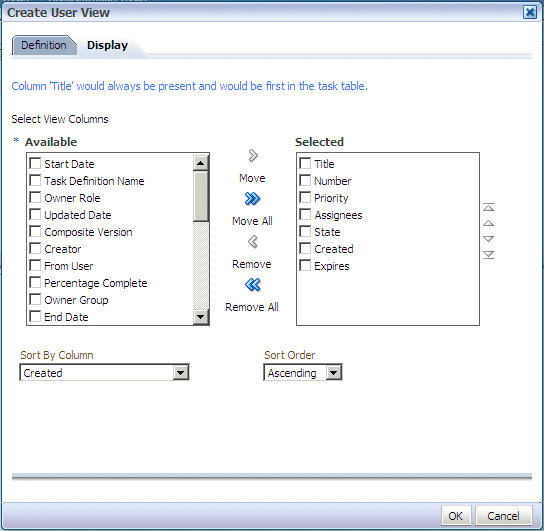
Description of "Figure 3-12 Displaying Fields in a Worklist View"
-
Select View Columns—Specify which columns you want to display in your task list. They can be standard task attributes or mapped attributes that were mapped for the specific task type. The default columns are the same as the columns in your inbox.
-
Sort by Column—Select a column on which to sort.
-
Sort Order—Select ascending or descending order.
-
-
Click OK.
-
In the Worklist Views section, click the view name.
-
Click the Edit icon.
-
Use the Definition and Display pages of the Edit User View dialog box to customize the view, as shown in Figure 3-13 and Figure 3-14, and click OK.
Figure 3-14 Customizing Fields in a Worklist View
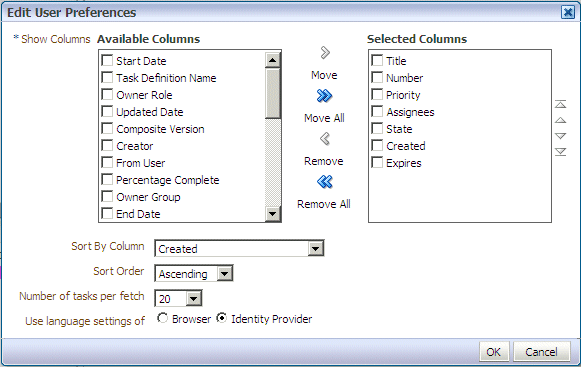
Description of "Figure 3-14 Customizing Fields in a Worklist View"
When you select and move items from the Available Columns list to the Selected Columns list (or vice-versa), the items remain selected. Therefore, if you select items to move back, the previously selected items are also moved. Ensure that you deselect items after moving them between the lists if you intend to move additional columns.
3.3 Claiming and Releasing Tasks in Process Workspace
If a task is assigned to a group or multiple users, then the task must be claimed first. Claim is the only action available in the Task Action list for group or multiuser assignments. After a task is claimed, all applicable actions are listed.
If a task is assigned to a group or multiple users, it can be released by the user who claimed it. Any of the other assignees can then claim and complete the task.
To claim a task, open it in the Task Details page, then click the Claim button.
Similarly, to release a task, open it in the Task Details page, then click the Release button.
Figure 3-15 shows part of a Task Details page with the Claim button in the upper right corner.
3.4 Setting Accessibility Preferences in Process Workspace
To set accessibility preferences:
-
In the upper right corner of Process Workspace, click Preferences.
-
In the Configuration Areas panel, select Accessibility. The Select Accessibility page appears in the right pane as shown in Figure 3-16.
-
Select your accessibility preferences, then click OK.
3.5 Providing a Digital Certificate in Process Workspace
A digital certificate establishes the participant's credentials. It is issued by a certification authority (CA). It contains your name, a serial number, expiration dates, a copy of the certificate holder's public key (used for encrypting messages and digital signatures), and the digital signature of the certificate-issuing authority so that a recipient can verify that the certificate is real.
To provide a digital certificate:
-
In the upper right corner of Process Workspace, click Preferences.
-
In the navigation bar on the left, click Certificates.
-
Upload the certificate to use to sign your decision, as shown in Figure 3-17.
When signing a task outcome using your certificate, you must upload the entire chain of certificates through Process Workspace as a
.P7B(PKCS7 format) file, not just the one certificate issued to you by the certificate issuer. The entire chain can be exported through Internet Explorer. Mozilla Firefox does not let you export the chain as a.P7Bfile. Therefore, you can perform the following steps:-
Export the chain from Mozilla Firefox as a
.P12file (PKCS12 format that also contains your private key). -
Import the
.P12file in Internet Explorer. -
Export it again from Internet Explorer as a
.P7Bfile. -
Upload it through Process Workspace.
Note the following important points when providing your certificate to the system. Otherwise, you cannot use your certificate to sign your decisions on tasks.
-
The PKCS7 file format is a binary certificate format. Select this option if you have a standalone certificate file stored on your disk.
-
The PKCS12 file format is a keystore format. Select this option if you have your certificate stored inside a keystore.
-
If you want to copy and paste the contents of the certificate, select Type or Paste Certificate Contents and paste the BASE64-encoded text into the field. Do not paste a certificate in any other format into this field. Likewise, if you choose to upload a certificate, do not upload a BASE64-encoded certificate. Only PKCS12- and PKCS7- formatted files are supported for uploads.
-
-
Return to the task list by clicking the Home link in the upper right corner of Process Workspace.
-
Click a task to approve or reject.
The task details are displayed.
-
Click either Approve or Reject.
Details about the digital signature are displayed.
-
For a task that has a signature policy, click Sign.
The Text Signing Report dialog box appears.
-
Select the certificate from the list to use to sign your decision.
-
Enter the master password of the Web browser that you are using.
-
Click OK.
The Web browser signs the string displayed in the upper half of the Text Signing Request with the certificate you selected and invokes the action (approval or rejection) that you selected. The task status is appropriately updated in the human workflow service.
If you are a developer and want more information about how certificates are uploaded and used, see Oracle Fusion Middleware Developer's Guide for Oracle SOA Suite.
3.6 Reassigning and Delegating Tasks in Process Workspace
To reassign or delegate a task:
-
From the Actions list, select Reassign, as shown in Figure 3-18.
-
Select Reassign or Delegate.
Delegate differs from Reassign in that the privileges of the delegatee are based on the delegator's privileges. This function can be used by managers' assistants, for example.
-
Provide or browse for a user or group name, as shown in Figure 3-19.
A supervisor can always reassign tasks to any of his reportees.
-
Move names to the Selected area and click OK.
You can reassign to multiple users or groups. One of the assignees must claim the task, as shown in Figure 3-20.
Note:
When task details have been upgraded from an earlier release, you may see a "Request Failed" error when executing the Reassign action. Actually, the reassign completes, and when you click OK again, a popup says the task is already assigned.
To eliminate the error message, upgrade your taskflow applications by opening them in Oracle JDeveloper, then redeploy the taskform.
3.7 Adding Comments and Attachments to Tasks in Process Workspace
You can add comments and attachments to a task by using the Task Details page.
For details about the Task Details page, see Section 2.3.1.2, "The Process Workspace Task Details Page"
-
In the Tasks tab page, from the worklist pane, select the task to which you want to add a comment. The details for that task appear.
-
In the Comments section of the Task Details page, click Create. The Create Comment dialog box appears as shown in Figure 3-21.
-
In the Create Comment dialog box, enter your comment, then select to share the comment with either of the following:
-
Only task participants. This option shares the comment with previous and future assignees of this particular task.
-
All process participants. This option shares the comment with all participants in the process, regardless of the tasks assigned to them.
Note:
If you are the initiator of the task, then your comment is shared with all process participants and not only with task assignees. The option to share with only task participants is not available to you.
-
-
Click OK.
To add an attachment to a task:
-
In the Tasks tab page, from the worklist pane, select the task to which you want to add an attachment. The details for that task appear.
-
In the Attachments section of the Task Details page, click Add. The Add Attachment dialog box appears.
-
In the Add Attachment dialog box, select to share the attachment with either of the following:
-
Only task participants. This option shares the attachment with previous and future assignees of this particular task.
-
All process participants. This option shares the attachment with all participants in the process, regardless of the tasks assigned to them.
-
-
Select the attachment type.
If the task is not using Oracle WebCenter Content, then you see the following options:
-
URL. Selecting this option opens fields in which you specify the name and URL of the file.
-
Desktop File. Selecting this option opens a search field from which to browse for the file on your computer.
If the task is using Oracle WebCenter Content, then you see the following options:
-
URL. Selecting this option opens fields in which you specify the name and URL of the file.
-
Upload File to WebCenter Content. Selecting this option uploads the desktop file to Oracle WebCenter Content. When you select it, another dialog box prompts you for some or all of the following depending on how the task is modeled:
-
Description (optional)
-
Folder name: The folder in WebCenter Content server where the attachment is uploaded. You must type the full folder path in WebCenter Content server
-
Document type: From this list, select the WebCenter Content document type.
-
Account (optional): From this list, select the account name.
-
Revision (optional): Type an integer for revision.
-
Release date (optional): Select the date at which the document is released. Prior to this date, the WebCenter Content document is not visible to WebCenter Content users.
-
Expiration date (optional): The date when the document expires. After this date, the WebCenter Content document is no longer visible to Oracle WebCenter Content users.
-
-
Associate WebCenter Content Document. Selecting this option opens another dialog box prompting you for the document identifier. You can search for it by clicking the spyglass icon and, once you have located it, clicking OK.
Once you have selected the attachment type, click OK.
-
To delete an attachment from a task:
-
In the Tasks tab page, from the worklist pane, select the task from which you want to delete an attachment. The details for that task appear in the Task Details pane.
-
In the Task Details pane, in the Attachments section, select the attachment you want to delete and click Delete. The Delete Attachment dialog box prompts you to confirm the deletion.
-
Click OK.
-
In the Task Details pane, from the Actions list, select Save as shown in Figure 3-22. The attachment is deleted from the task.
Note:
If the attachment is stored in a content server such as WebCenter Content, then it is not deleted from the content server. If the attachment is stored in the SOA workflow repository, then you can access it by viewing the task snapshot from the task history.
Figure 3-22 Deleting an Attachment from a Task
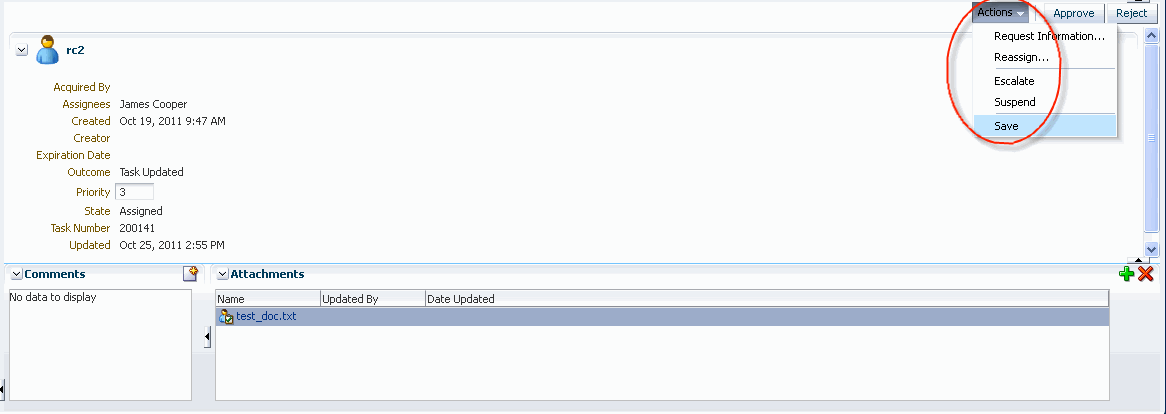
Description of "Figure 3-22 Deleting an Attachment from a Task"
3.8 Requesting Information in Process Workspace
-
From the Task Actions list, select Request Information, as shown in Figure 3-23.
-
Request information from a past approver or search for a user name, or push the task back to the previous assignee, as shown in Figure 3-24.
Figure 3-24 Requesting Information from Past Approvers or Another User, or Pushing the Task Back
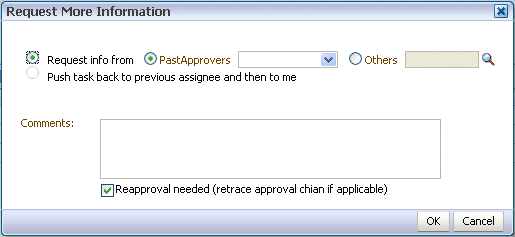
Description of "Figure 3-24 Requesting Information from Past Approvers or Another User, or Pushing the Task Back"
If you use the Search icon to find a user name, the Identity Browser appears, as shown in Figure 3-25.
Note:
If you are in a multi-tenancy environment, search for a user simply by the user identifier and not by the tenant identifier. For example, if the user identifier is jstein and the tenant identifier is company_name.jstein, you would search by using jstein.
-
Click OK.
3.9 Setting Rules, Vacation Periods, and Notification Preferences in Process Workspace
Rules act on tasks, either a specific task type or all the tasks assigned to a user or group. To set rules, from the Process Workspace toolbar, select Preferences. The Preferences window appears as shown in Figure 3-26.
Figure 3-26 Configuration Areas: My Rules Page
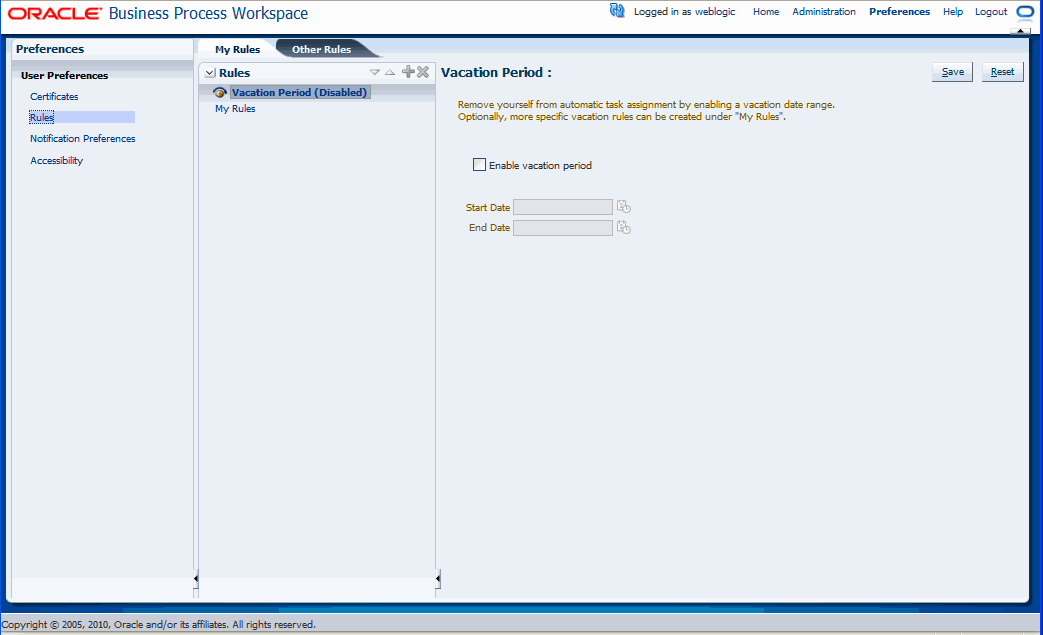
Description of "Figure 3-26 Configuration Areas: My Rules Page"
A rule cannot always apply to all circumstances in which it is used. For example, if a rule applies to multiple task types, it may not be possible to set the outcome for all tasks, because different tasks can have different outcomes.
Rules are executed in the order in which they are listed.
If a rule meets its filter conditions, then it is executed and no other rules are evaluated. For your rule to execute, you must be the only user assigned to that task. If the task is assigned to multiple users (including you), the rule does not execute.
You cannot specify business rules for ToDo tasks.
This section contains these topics:
-
Section 3.9.1, "How to Create User Rules in Process Workspace"
-
Section 3.9.2, "How to Create Group Rules in Process Workspace"
-
Section 3.9.3, "How to Enable a Vacation Period in Process Workspace"
3.9.1 How to Create User Rules in Process Workspace
-
From the Process Workspace toolbar, select Configuration. The Configuration Areas window is displayed.
-
In the User Preferences area, click Rules. The My Rules and Other Rules pages appear in the right pane. The My Rules page is selected.
-
In the My Rules page, in the Rules section, select My Rules. The My Rule screen appears in the right pane.
-
Provide a name for the rule.
-
If the rule is a vacation rule, select Use as a vacation rule. The start and end dates of the rule are automatically synchronized with the vacation period.
For instructions about setting a vacation period that is synchronized with the vacation rule, see Section 3.9.3, "How to Enable a Vacation Period in Process Workspace."
-
In the Apply only to task type(s) field, browse for task types to which the rule applies. If a task is unspecified, then the rule applies to all tasks. If a task type is specified, then any mapped attribute mapped for that task type can be used in the rule condition.
-
Select Execute rule only between these dates and provide rule execution dates.
-
In the IF area, add rule conditions. These are filters that further define the rule, such as specifying that a rule acts on priority 1 tasks only, or that a rule acts on tasks created by a specific user. The conditions can be based on standard task attributes and any mapped attributes that were mapped for the specific tasks. See Section 9.2.1.1, "How to Specify Mapped Attributes" for more information.
-
In the THEN area, select actions to be taken. User rules do the following actions:
-
Reassign to—You can reassign tasks to subordinates or groups you manage. If you were granted the BPMWorkflowReassign role, then you can reassign tasks to any user or group.
-
Delegate to—You can delegate to any user or group. Any access rights or privileges for completing the task are determined according to the original user who delegated the task. (Any subsequent delegations or reassignments do not change this from the original delegating user.)
-
Set outcome to—You can specify an automatic outcome if the workflow task was designed for those outcomes, for example, accepting or rejecting the task. The rule must be for a specific task type. If a rule is for all task types, then this option is not displayed.
-
Take no action—Use this action to prevent other more general rules from applying. For example, to reassign all your tasks to another user while you are on vacation, except for loan requests, for which you want no action taken, then create two rules. The first rule specifies that no action is taken for loan requests; the second rule specifies that all tasks are reassigned to another user. The first rule prevents reassignment for loan requests.
-
-
Click Save.
The new rule appears under the My Rules node.
3.9.2 How to Create Group Rules in Process Workspace
Creating a group rule is similar to creating a user rule, with the addition of a list of the groups that you (as the logged-in user) manage. Examples of group rules include:
-
Assigning tasks from a particular customer to a member of the group
-
Ensuring an even distribution of task assignments to members of a group by using round-robin assignment
-
Ensuring that high-priority tasks are routed to the least busy member of a group
Group rules do the following actions:
-
Assign to member via—You can specify a criterion to determine which member of the group gets the assignment. This dynamic assignment criterion can include round-robin assignment, assignment to the least busy group member, or assignment to the most productive group member. You can also add your custom functions for allocating tasks to users in a group.
-
Assign to—As with user rules, you can assign tasks to subordinates or groups you directly manage. If you have been granted the BPMWorkflowReassign role, then you can reassign tasks to any user or group (outside your management hierarchy).
-
Take no action—As with user rules, you can create a rule with a condition that prevents a more generic rule from being executed.
-
From the Process Workspace toolbar, select Preferences. The Preferences window is displayed.
-
In the User Preferences area, click Rules. The My Rules and Other Rules pages appear in the right pane. The My Rules page is selected.
-
Click the Other Rules tab.
-
Select Group from the list.
-
Enter a group name and click the Search icon, or enter a group name.
The Identity Browser dialog box opens for you to find and select a group.
-
Select the group name under the Group Rules node and click Add, as shown in Figure 3-27.
-
Provide group rule information and click Save.
-
Provide a name for the rule.
-
Browse for task types to which the rule applies.
-
Provide rule execution dates.
-
In the IF area, add rule conditions.
-
In the THEN area, select the actions to be taken: (Assign to member via, Assign to, or Take no action), as shown in Figure 3-27.
The new rule appears under the Group Rules node.
-
3.9.3 How to Enable a Vacation Period in Process Workspace
You can set a vacation period so that you are removed from automatic task assignment during the dates you specify.
Vacation rules are not executed for ToDo tasks. See Section 3.9.1, "How to Create User Rules in Process Workspace" for how to set a vacation rule that is synchronized with the vacation period.
-
Click the Preferences link. The Preferences page appears.
-
In the User Preferences panel, click Rules. The right pane displays the Rules panel with the My Rules page selected. Adjacent and to the right of the My Rules page, the Vacation Period page appears.
-
Select Enable vacation period.
-
Provide start and end dates.
-
Click Save. The vacation period is enabled.
3.9.4 Specifying Notification Settings
You can configure the notification settings to control how, when, and where you receive messages in cases when you have access to multiple communication channels (delivery types). Specifically, you can define messaging filters (delivery preferences) that specify the channel to which a message should be delivered, and under what circumstances.
For example, you might want to create filters for messages received from customers with different Service Level Agreements (SLA), specifying to be notified through business phone and SMS channels for customers with a premium SLA and by EMAIL for customers with a nonpremium SLA.
3.9.4.1 Messaging Filter Rules
A messaging filter rule consists of rule conditions and rule actions. A rule condition consists of a rule attribute, an operator, and an associated value. A rule action is the action to be taken if the specified conditions in a rule are true.
3.9.4.1.1 Data Types
Table 3-4 lists data types supported by messaging filters. Each attribute has an associated data type, and each data type has a set of predefined comparison operators.
Table 3-4 Data Types Supported by Messaging Filters
| Data Type | Comparison Operators |
|---|---|
|
Date |
isEqual, isNotEqual, isGreaterThan, isGreaterThanOrEqual, isLessThan, isLessThanOrEqual, Between, isWeekday, isWeekend |
|
Time |
isEqual, isNotEqual, Between |
|
Number |
isEqual, isNotEqual, Between, isGreaterThan, isGreaterThanOrEqual, isLessThan, isLessThanOrEqual |
|
String |
isEqual, isNotEqual, Contains, NotContains |
Note:
The String data type does not support regular expressions.
3.9.4.1.2 Attributes
Table 3-5 lists the predefined attributes for messaging filters.
Table 3-5 Predefined Attributes for Messaging Filters
| Attribute | Data Type |
|---|---|
|
Total Cost |
Number |
|
From |
String |
|
Expense Type |
String |
|
To |
String |
|
Application Type |
String |
|
Duration |
Number |
|
Application |
String |
|
Process Type |
String |
|
Status |
String |
|
Subject |
String |
|
Customer Type |
String |
|
Time |
Time |
|
Group Name |
String |
|
Processing Time |
Number |
|
Date |
Date |
|
Due Date |
Date |
|
User |
String |
|
Source |
String |
|
Amount |
Number |
|
Role |
String |
|
Priority |
String |
|
Customer Name |
String |
|
Expiration Date |
Date |
|
Order Type |
String |
|
Organization |
String |
|
Classification |
String |
|
Service Request Type |
String |
3.9.4.2 Rule Actions
For a given rule, a messaging filter can define the following actions:
-
Send No Messages: Do not send a message to any channel.
-
Send Messages to All Selected Channels: Send a message to all specified channels in the address list.
-
Send to the First Available Channel: Send a message serially to channels in the address list until one successful message is sent. This entails performing a send to the next channel when the current channel returns a failure status. This filter action is not supported for messages sent from the human workflow layer.
3.9.4.3 Managing Messaging Channels
In Oracle BPM Worklist, messaging channels represent both physical channels, such as business mobile phones, and also email client applications running on desktops. Specifically, Oracle BPM Worklist supports the following messaging channels:
-
EMAIL
-
IM
-
MOBILE
-
SMS
-
VOICE
-
WORKLIST
Note the following about message channels:
-
Addresses for messaging channels are fetched from the configured identity store.
-
SMS and MOBILE notifications are sent to the mobile phone number.
-
VOICE notifications are sent to the business phone number.
-
No special notification is sent when the messaging channel preference is WORKLIST. Instead, log in to Oracle BPM Worklist to view tasks.
-
EMAIL is the default messaging channel preference when a preferred channel has not been selected.
You can use the Messaging Channels tab to view, create, edit, and delete messaging channels.
3.9.4.3.1 Viewing Your Messaging Channels
You can display your existing messaging channels.
-
Click the Preferences link.
-
Click the Notification Preferences.
-
Click the Messaging Channels tab.
The My Messaging Channels list appears (Figure 3-28) and displays the following information:
-
Name: The name of the messaging channel.
-
Type: The type of messaging channel, such as EMAIL or SMS.
-
Address: The address for the channel, such as a phone number or email address.
-
Default: Specifies whether this channel is the default messaging channel.
-
-
Click View > Columns and select the columns to display or hide.
You can also click View > Reorder Columns to display a dialog to reorder the displayed columns.
Messaging channel names and addresses are retrieved from the underlying identity store, such as Oracle Internet Directory.
3.9.4.3.2 Creating, Editing, and Deleting a Messaging Channel
Oracle BPM Worklist uses an underlying identity store, such as Oracle Internet Directory, to manage messaging channels and addresses. Therefore, you cannot directly create, modify, or delete messaging channels using Oracle BPM Worklist.
To perform these actions, contact the system administrator responsible for managing your organization's identity store.
3.9.4.4 Managing Messaging Filters
You can use the Messaging Filters tab to define filters that specify the types of notifications you want to receive along with the channels through which to receive these notifications. You can do this through a combination of comparison operators (such as is equal to, is not equal to), attributes that describe the notification type, content, or source, and notification actions, which send the notifications to the first available messaging channels, all messaging channels, or to no channels (effectively blocking the notification).
For example, you can create a messaging filter called Messages from Lise, that retrieves all messages addressed to you from your boss, Lise. Notifications that match all of the filter conditions might first be directed to your business mobile phone, for instance, and then to your business email if the first messaging channel is unavailable.
3.9.4.4.1 Viewing Messaging Filters
You can display your existing messaging filters.
To view your messaging filters:
-
Click the Notification tab.
-
Click the Messaging Filters tab.
The My Messaging Filters list appears (Figure 3-29) and displays the following information:
-
Filter Name: The name of the messaging filter
-
Description: An optional description of the messaging filter
-
-
Click View > Columns and select the columns to display or hide.
You can also click View > Reorder Columns to display a dialog to reorder the displayed columns.
3.9.4.4.2 Creating Messaging Filters
-
Click Create.
The Messaging Filters page appears, as shown in Figure 3-30.
-
Specify the following information:
-
Filter Name: The name of the messaging filter.
-
Description: An optional description for the messaging filter.
-
-
Define the filter conditions using the lists and fields in the Condition section, as follows:
-
Select whether notifications must meet all of the conditions or any of the conditions by selecting either the All of the following conditions or the Any of the following conditions options.
-
Select the attribute from the list.
-
Select the operator, such as isEqual, from the list.
-
Type the value of the condition in the text box.
-
Click Add to add the condition to the list.
-
Repeat these steps to add more filter conditions. To remove a filter condition, click Delete.
-
-
Select from the following messaging options in the Action section:
-
Send No Messages: Do not send a message to any channel.
-
Send Messages to All Selected Channels: Send a message to all specified channels in the address list.
-
Send to the First Available Channel: Send a message serially to channels in the address list until one successful message is sent. This entails performing a send to the next channel when the current channel returns a failure status.
-
-
To set the delivery channel, select a channel from the Add Notification Channel list and click Add. To remove a channel, click Delete.
-
Use the up and down arrows to prioritize channels. If available, the top-most channel receives messages meeting the filter criteria if you select Send to the First Available Channel.
-
Click OK.
The messaging filter appears on the My Messaging Filters page. The My Messaging Filters page enables you to edit or delete the channel. Click Cancel to dismiss the dialog without creating the filter.
3.9.4.4.3 Editing a Messaging Filter
To edit a messaging filter:
-
Select the filter on the My Messaging Filters page.
-
Click Edit.
-
Click OK to update the messaging filter. Click Cancel to dismiss the dialog without modifying the filter.
3.10 Creating ToDo Tasks and Subtasks in Process Workspace
Use the Create ToDo Task dialog, shown in Figure 3-31, to create a top-level ToDo task for yourself or others. This task is not associated with a business task.
ToDo tasks appear in the assignee's Inbox.
You can create ToDo tasks that are children of other ToDo tasks or business tasks. A ToDo task can have only one level of child ToDo tasks. When all child ToDo tasks are 100% complete, the parent ToDo task is also marked as completed. If the parent ToDo task is completed, then child ToDo tasks are at 100% within the workflow system. If the parent is a business task, the child ToDo is not marked as completed. You must set the outcome and complete it. If you explicitly set a ToDo task to 100%, there is no aggregation on the parent task.
ToDo tasks can be reassigned, escalated, and so on, and deleted (logical delete) and purged (physical delete). Reassignment, escalation, and so on of the parent task does not affect the assignment of any child ToDo tasks. The completion percentage of a ToDo task can be reset to less than 100% after it is completed.
Assignment rules (such as vacation rules) are not applied to ToDo tasks. You cannot specify business rules for ToDo tasks.
-
From the Actions list, select Create TODO Task, as shown in Figure 3-32.
-
Provide details in the Create ToDo Task dialog, shown in Figure 3-31, and click OK.
-
Task Title: Enter anything that is meaningful to you.
-
Category: Enter anything that is meaningful to you.
-
Priority: Select from 1 (highest) to 5 (lowest)
-
Percentage Complete: This attribute indicates how much of the task is completed. 100% sets the attribute as completed.
-
Due Date: The due date does not trigger an expiration. You can also see overdue tasks. The start date need not be the current date.
-
StartDate: The task start date.
-
Assignee: You can assign yourself or someone else.
-
3.11 Acting on Tasks that Require Passwords in Process Workspace
If a human task was set up to require a password, then when you act on it, you must provide the password when prompted, as shown in Figure 3-33.
Figure 3-33 Acting on a Task That Requires a Password
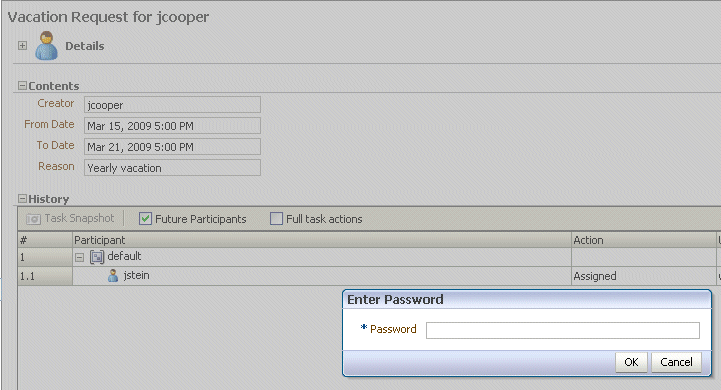
Description of "Figure 3-33 Acting on a Task That Requires a Password"
3.12 Acting on a Task that Requires a Digital Signature in Process Workspace
Oracle Business Process Management Workspace supports the signature policy created in the human task:
-
No signature required — Participants can send and act on tasks without providing a signature.
-
Password required — Participants must specify their login passwords.
-
Digital certificate (signature) required —Participants must possess a digital certificate before being able to send and act on tasks. A digital certificate contains the digital signature of the certificate-issuing authority so that anyone can verify that the certificate is real. A digital certificate establishes the participant's credentials. It is issued by a certification authority (CA). It contains your name, a serial number, expiration dates, a copy of the certificate holder's public key (used for encrypting messages and digital signatures), and the digital signature of the certificate-issuing authority so that a recipient can verify that the certificate is real.
The evidence store service is used for digital signature storage and nonrepudiation of digitally-signed human workflows.
For more information about digital signatures and the evidence store service, see Section 3.14, "Evidence Store Service and Digital Signatures".
When you act on a task that has a signature policy, the Sign button appears, as shown in Figure 3-34.
Figure 3-34 Digital Signature Task Details

Description of "Figure 3-34 Digital Signature Task Details"
To use a certificate for digitally signing tasks, you must first upload the certificate.
To upload a certificate for a digital signature:
-
In the upper right corner of Oracle BPM Worklist, click Preferences.
-
In the navigation bar on the left, click Certificates.
-
Upload the certificate to use to sign your decision, as shown in Figure 3-35.
When signing a task outcome using your certificate, you must upload the entire chain of certificates through Oracle BPM Worklist as a
.P7B(PKCS7 format) file, not just the one certificate issued to you by the certificate issuer. The entire chain can be exported through Internet Explorer. Mozilla Firefox does not enable you to export the chain as a.P7Bfile. Therefore, you can perform the following steps:-
Export the chain from Mozilla Firefox as a .P12 file (PKCS12 format that also contains your private key).
-
Import the
.P12file in Internet Explorer. -
Export it again from Internet Explorer as a
.P7Bfile. -
Upload it through Oracle BPM Worklist.
Note the following important points when providing your certificate to the system. Otherwise, you cannot use your certificate to sign your decisions on tasks.
-
The PKCS7 file format is a binary certificate format. Select this option if you have a standalone certificate file stored on your disk.
-
The PKCS12 file format is a keystore format. Select this option if you have your certificate stored inside a keystore.
-
If you want to copy and paste the contents of the certificate, select Type or Paste Certificate Contents and paste the BASE64-encoded text into the field. Do not paste a certificate in any other format into this field. Likewise, if you choose to upload a certificate, do not try to upload a BASE64-encoded certificate. Only PKCS12 and PKCS7 formatted files are supported for uploads.
-
-
Return to the task list by clicking the Home link in the upper-right corner of Process Workspace.
-
Click a task to approve or reject. The task details are displayed.
-
Click either Approve or Reject. Details about the digital signature are displayed.
-
For a task that has a signature policy, click Sign. The Text Signing Report dialog appears.
-
Select the certificate from the list to use to sign your decision.
-
Enter the master password of the web browser that you are using.
-
Click OK.
The web browser signs the string displayed in the upper half of the Text Signing Request with the certificate you selected and invokes the action (approval or rejection) that you selected. The task status is appropriately updated in the human workflow service.
3.13 Routing Tasks in Process Workspace
If the human task was designed to permit ad hoc routing, or if no predetermined sequence of approvers was defined, then the task can be routed in an ad-hoc fashion in the worklist. For such tasks, a Route button appears on the task details page. From the Route page, you can look up one or more users for routing. When you specify multiple assignees, you can select whether the list of assignees is for simple (group assignment to all users), sequential, or parallel assignment.
-
From the Task Actions list, select Adhoc Route, as shown in Figure 3-36.
-
Select an action and a routing option, as shown in Figure 3-37.
-
Single Approver: Use this option for a single user to act on a task. If the task is assigned to a role or group with multiple users, then one member must claim the task and act on it.
-
Group Vote: Use this option when multiple users, working in parallel, must act, such as in a hiring situation when multiple users vote to hire or reject an applicant. You specify the voting percentage that is needed for the outcome to take effect, such as a majority vote or a unanimous vote, as shown in Figure 3-38.
Figure 3-38 Providing Consensus Information

Description of "Figure 3-38 Providing Consensus Information"
-
Chain of Single Approvers: Use this option for a sequential list of approvers. The list can comprise any users or groups. (Users are not required to be part of an organization hierarchy.)
-
-
Add optional comments for the next participant on the route.
-
Provide or search for user or group names; then move the names to the Selected area.
-
Click OK.
3.14 Evidence Store Service and Digital Signatures
The evidence store service is used for digital signature storage and nonrepudiation of digitally-signed human workflows. A digital signature is an electronic signature that authenticates the identity of a message sender or document signer. This ensures that the original content of the message or document sent is unchanged. Digital signatures are transportable, cannot be imitated by others, and are automatically time-stamped. The ability to ensure that the original signed message arrived means that the sender cannot repudiate it later. Digital signatures ensure that a human workflow document:
-
Is authentic
-
Has not been forged by another entity
-
Has not been altered
-
Cannot be repudiated by the sender
A cryptographically-based digital signature is created when a public key algorithm signs a sender's message with a sender's private key.
During design time, signatures are enabled for the task. During runtime in Process Workspace, when a user approves or rejects the task, the web browser:
-
Asks the user to choose the private key to use for signing.
-
Generates a digital signature using the private key and task content provided by Oracle BPM Worklist.
Notes:
-
The certificate refers to a Personal Information Exchange Syntax Standard (PFX) file that includes a certificate and a private key, and is protected by a simple text password. PFX specifies a portable format for storing or transporting a user's private keys, certificates, miscellaneous secrets, and so on.
-
The possession of a private key that corresponds to the public key of a certificate is sufficient to sign the data, because the signature is verifiable through the public key in the certificate. However, no attempt is made to correlate the name of a user of a certificate with the person updating it. For example, user
jsteincan sign using the private key of usercdickensifjsteinhas that private key.
The following digital signature features are supported:
-
PKCS7 signatures based on X.509 certificates
-
Browser-based, digitally-signed content without attachments
You can search the evidence store, as shown in Figure 3-39.
